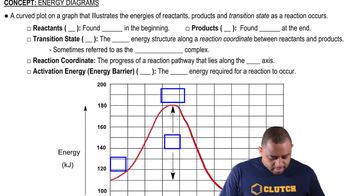(a) The activation energy for the isomerization of methyl isonitrile (Figure 14.6) is 160 kJ>mol. Calculate the fraction of methyl isonitrile molecules that has an energy equal to or greater than the activation energy at 500 K. (b) Calculate this fraction for a temperature of 520 K. What is the ratio of the fraction at 520 K to that at 500 K?
For the elementary process N2O5(g) → 2NO2(g) + NO3(g), the activation energy (Ea) and overall ΔE are 154 kJ/mol and 136 kJ/mol, respectively. (a) Sketch the energy profile for this reaction, and label Ea and ΔE.
 Verified step by step guidance
Verified step by step guidanceKey Concepts
Activation Energy (Ea)

Enthalpy Change (ΔE)

Energy Profile Diagram

The gas-phase reaction Cl(g) + HBr(g) → HCl(g) + Br(g) has an overall energy change of -66 kJ. The activation energy for the reaction is 7 kJ. (a) Sketch the energy profile for the reaction, and label Ea and ΔE.
The gas-phase reaction Cl(g) + HBr(g) → HCl(g) + Br(g) has an overall energy change of -66 kJ. The activation energy for the reaction is 7 kJ. (b) What is the activation energy for the reverse reaction?
Indicate whether each statement is true or false. (c) Increasing the reaction temperature increases the fraction of successful collisions between reactants.
Indicate whether each statement is true or false. (a) If you measure the rate constant for a reaction at different temperatures, you can calculate the overall enthalpy change for the reaction.
Indicate whether each statement is true or false. (b) Exothermic reactions are faster than endothermic reactions.
